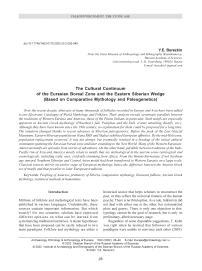The cultural continuum of the Eurasian boreal zone and the Eastern Siberian wedge (based on comparative mythology and paleogenetics)
Автор: Berezkin Y.E.
Журнал: Archaeology, Ethnology & Anthropology of Eurasia @journal-aeae-en
Рубрика: Paleoenvironment, the stone age
Статья в выпуске: 2 т.50, 2022 года.
Бесплатный доступ
Over the recent decade, abstracts of many thousands of folktales recorded in Europe and Asia have been added to our Electronic Catalogue of World Mythology and Folklore. Their analysis reveals systematic parallels between the traditions of Western Eurasia and America, those of the Plains Indians in particular. Such motifs are especially apparent in Ancient Greek mythology (Phaethon’s fall, Pasiphae and the bull, cranes attacking dwarfs, etc.). Although they have been known since the 19th century, no explanation for them could be proposed for a long time. The situation changed thanks to recent advances in Siberian paleogenetics. Before the peak of the Last Glacial Maximum, Eastern Siberian populations (Yana RHS and Malta) exhibited European affinities. By the mid-Holocene, population replacement occurred. It was not abrupt, but eventually resulted in a breakup of the initial cultural continuum spanning the Eurasian boreal zone and later extending to the New World. Many of the Western Eurasian–American motifs are episodes from stories of adventures. On the other hand, parallels between traditions of the Indo-Pacific rim of Asia and America mostly relate to motifs that are mythological in the narrow sense (etiological and cosmological), including early ones, evidently stemming from Africa. From the Hunno-Sarmatian, if not Scythian age onward, Southern Siberian and Central Asian motifs had been transferred to Western Eurasia on a large scale. Classical sources mirror an earlier stage of European mythology, hence the difference between the Ancient Greek set of motifs and that peculiar to later European traditions.
Peopling of America, prehistory of Siberia, comparative mythology, Eurasian folklore, Ancient Greek mythology, statistical methods in humanities
Короткий адрес: https://sciup.org/145146783
IDR: 145146783 | DOI: 10.17746/1563-0110.2022.50.2.028-040
Текст научной статьи The cultural continuum of the Eurasian boreal zone and the Eastern Siberian wedge (based on comparative mythology and paleogenetics)
Millions of folklore and mythological texts have been published in various languages. Undoubtedly, these sources contain important information. But which exactly? For two centuries, scholars have expressed different opinions on what can be learned from systematizing traditional narratives. A dozen hypotheses that have been proposed can be easily reduced to two main paradigms. Folklore and mythology are either a historical source that helps scholars to reconstruct the past, or they reflect the universal features of the human psyche. There is no third option. As a rule, folklorists did not deal with either one or the other, but systematized plots and genres. There is only one objection to this: typology cannot be the goal of research, but is only its preliminary, albeit necessary stage.
Regardless of some disputable suggestions, T. Kuhn was right when he insisted that followers of various paradigms were unable to convince each other (2003).
Scholarly fields originate and disappear only together with their representatives. People may argue about specific issues, but not about general approaches. For a historian, it is clear that everything that exists emerged in a certain place and at certain time. We agree that culture embodies something intrinsic to humans as a species, but in this case we are not interested in universal elements—psychologists and ethologists should address them. As far as folklore and mythology are concerned, mapping irrefutably proves that plots, motifs, and genres of folklore are not universal. Their specific forms and variants are typical of some regions and are unknown in others, and these differences rarely, if ever, correlate with natural, social, and economic features (trivial cases, such as absence of myths explaining the ebb and flow of tides among the inhabitants of areas remote from the sea should not be even mentioned). The area distribution of the elements of folklore and mythology reflects contacts between people and outlines the ancient spheres of interaction.
There are many reasons why cultural anthropology and folklore ceased to be the fields of history in the 1920s. Yet, it is important that ethnographic and folklore evidence, which had been collected, has not lost its value because of this. As the remote past of mankind takes on a concrete shape thanks to successes of archaeology and genetics, the body of folklore and ethnographic data turns into unique information resource shedding some light on the aspects of the past that are inaccessible to other fields of history.
The scholarly field that we represent does not yet have a stable name. It can be called “the corpus folklore”, although admittedly, this term is obscure. In essence, the idea is that historical information is contained not in individual mythological texts, not in the plots of narratives, but in the distribution areas of the elements extracted from the texts, which coincide with areas of specific cultural and historical communities. The time when such communities existed is known thanks to archaeologists and geneticists. This makes it possible (in the first approximation) to give the terminus ante quem to the emergence of mythological images and narrative episodes.
American connections with Ancient Greek mythology
In the late 19th century, F. Boas, the founder of professional American anthropology, recorded the myths of the Native Americans who lived on the coast of British Columbia, and discovered an episode similar to the Ancient Greek myth about cranes and pygmies (2002: 213–215). Somewhere far away, there lived dwarfs endowed with remarkable strength, but suffering harm from migratory birds that regularly attacked them, such as geese, swans, ducks, and cranes (Shtal, 1982). The story usually unfolded about how a man who found himself among the dwarfs easily defeated the birds.
Boas did not attempt to comment upon this parallel and did not even include this motif into the list of traditions he studied (2002: 672–674), but what could he do at that time? Scholars have identified texts on this subject among a large number of the peoples of Eurasia and especially America (Toivonen, 1937). We indicated most of the cases in an overview published a decade and a half ago* (Berezkin, 2007). Since then, similar episodes have also been found in France (Charente Department) and Germany (Rügen Island) (Karlin, 1991: 247–248; Haas, 1903: 157–159). These fairy tales incorporated ancient ideas that had lost their relevance. In a brief form, “Cranes and pygmies” have been found among the Evenks of China (Bäcker, 1988: 198–201). In the 20th century, such narratives almost disappeared from the folklore traditions of the Old World, and are known mainly from early records.
The plot of “Cranes and pygmies” contains several motifs-episodes with partially intersecting definitions**. In the Electronic Catalogue of World Mythology and Folklore***, these are numbers k22, k22a, k22aa, k22b, k22c, and k23 (Berezkin, Duvakin, (s.a.)). “Cranes and pygmies” appeared in three regions (Fig. 1). In the west of Eurasia, the plot has been found in Europe, Transcaucasus, and Western Asia (Arabic written tradition). In the Far East, relatively rich data are available in ancient and medieval Chinese sources. The same story among the Nanai people has survived in a unique record of the late 19th century (Shimkevich, 1897: 137). Most of the evidence collected pertain to the traditions of the New World. In North America, the corresponding narratives are spread over the territory between the extreme south of Alaska (the Tlingit people), northern Plains, Great Lakes (Fox), southeastern United States, and northern Mexico. One text was recorded among the Eskimos of Northwestern Alaska, but does not appear in most of the American
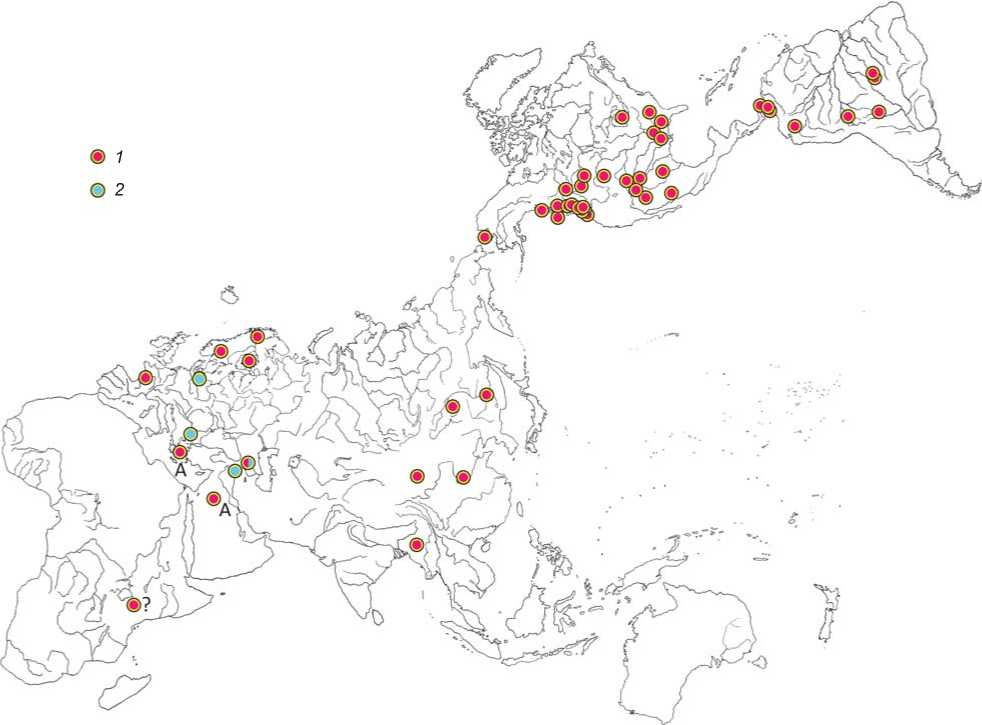
®1
о 2
Fig. 1 . Distribution of motifs “Cranes and pygmies” (k22 in the Electronic Catalogue) ( 1 ) and “Birds in the north – people in the south” (k22aa) ( 2 ).
Hereafter, letter “A” marks early written traditions; in this case, Ancient Greek and Arabic.
Arctic and Subarctic. In South America, this plot is less common than in North America, but also occurs in a large area: from the Isthmus of Panama to the upper Xingu River in Brazil.
This distribution suggests that the plot came to the New World in the early period of migration. Its independent emergence in America is unlikely. Episodes recorded in different traditions of the Old and New Worlds are not trivial and not common throughout the world. They have not been found either in Southeast Asia and Oceania, or in Africa. Among the Chagga people of East Africa, a myth was recorded about the birds that attack the rising sun every morning, mistaking it for grain, and people protect it (Millroth, 1965: 25–26). However, the connection of this variant with the rest variants is not obvious; in any case, it is the only one in the region. The plot of “Cranes and pygmies” is based on the concept of migratory birds, and should have originated somewhere in the north. It was most likely brought to South America along with peopling of the continent.
Motif k22aa “Birds in the north – people in the south” occurs in Europe (Germans, Bulgarians) and Transcaucasus (Georgians, Armenians): a person comes to a country whose inhabitants are birds that live with people in the summer and turn into people flying away to their own lands (Fig. 1). Although the fight between birds and dwarfs is not mentioned there, the motif of traveling to a country where migratory birds arrive may be relevant to the plot in question. In the Georgian version, motifs k22 and k22aa are combined in a single narrative.
The story about cranes and pygmies is not the only plot connecting Ancient Greek mythology with the Far East and especially with the New World. There are other plots, such as narratives about the Cretan King Minos and his wife Pasiphae. During copulation, Minos ejaculated poisonous creatures (what it was in particular is unknown), killing women, and Pasiphae had intercourse with the bull from whom she begot Minotaur. “Strange marriage” with a large quadruped (motif f34) and “Dangerous genitals” (f9a, f9b–f9e, f10, f11) in a mythological rather than anecdotal context are common motifs in the oral traditions of the Native Americans, but they are absent in the west of Eurasia and Africa (Berezkin, 2018a). The Greek example is one of a kind.
Another motif is Heracles’ extermination of the Stymphalian birds, which threw their feathers like arrows (in the Electronic Catalogue, this motif is k23a). It is unique for Western Eurasia, but is known to the Chukchi and Native Americans who inhabit the northwestern coast of North America, from British Columbia to the border of Oregon.
The presence of identical imagery and motifs in the Far East and America is not surprising—the Native Americans came to the New World from Asia. But what does this have to do with Greece or France?
The Greek written tradition is the only ancient Western Eurasian tradition for which we have extensive and varied data. In the number of motifs that we have identified in the sources of Greek Antiquity (260 among almost 3000 for the whole world) it is comparable to late folklore traditions of Europe. Half of these motifs are mythological in the narrow sense, and reflect ideas about the world. The other half consists of adventure and trickster-related motifs.
As opposed to the Ancient Greek tradition, early written traditions of India and China are similar to those in the folklore records of the 19th–20th centuries. They also contain sufficient evidence: 196 motifs for Ancient India and 150 for Ancient China, while 265 motifs are registered for the Hindi-speaking population of North India, 185 motifs for the Punjabis, 180 motifs for the Miao people, as well as 150 motifs for the Lisu people and the similar Tibetan-Burmese groups of Yunnan. In Mesoamerica, sets of motifs in the sources from the time of the Spanish conquest and in the Native American traditions of the 20th century are almost identical. And only the Ancient Greek mythology, after processing data on the occurrence of motifs, turns out to be closer not to the later traditions of its own region, but to the sets of mythological motifs in another part of the globe— America and Indo-Pacific Rim of Asia. This shift is statistically small, but noticeable (Fig. 2).
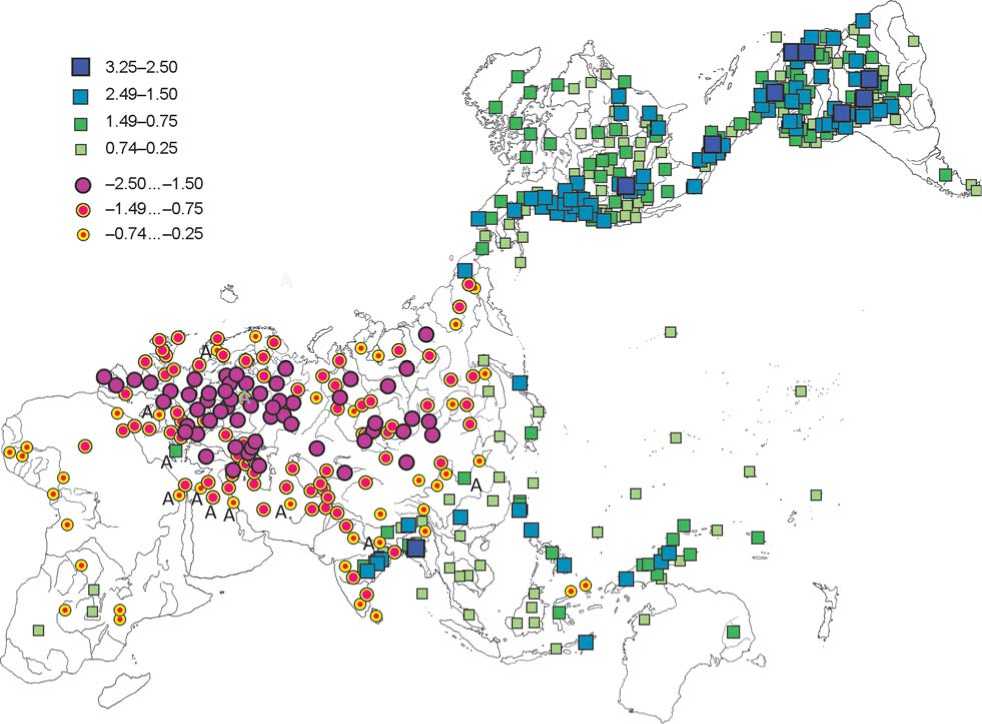
Fig. 2 . Results of statistical processing of data on the distribution of 490 cosmological and etiological motifs in 987 traditions of the world. Only the motifs that were found in both the Old and New Worlds have been taken into consideration. PC 2. Dispersion is 4.1 %. Traditions with the number of motifs <16 and absolute value of indices <0.25 are not shown.
Using factor analysis applied to statistical data processing, principal components (PC) were identified in a tremendous array of various parallels between traditions. The higher the correlation of a certain group of motifs with specific group of traditions, the higher the absolute values of conventional mathematical indices for the corresponding traditions. The first PC-s are significant; the rest are informational noise reflecting many multidirectional connections between the pairs and small groups of traditions. If traditions differ dramatically in the number of motifs, the software perceives the understudied traditions as objectively different from the well-studied traditions, opposing one to the other. However, such opposition only points to differences in availability of sources. Usually it is reflected by the first PC, while the second PC is the most significant. The data we provide are from the second PC.
Each PC is associated with two sets of traditions that are the least similar in their composition of motifs. The software gives them indexes with “+” or “–” signs. The more vividly the trend is expressed, the higher the absolute value of the index is. Each group with indices of the same sign corresponds to some community. Such communities, according to the terminology by R.N. Adams, are fragmentary and aggregated. Not only are they incapable of coordinating the actions of their members, but they also lack or almost lack selfidentification (Adams, 1975: Fig. 2). Their members are connected with each other only by a network of contacts a little more dense than contacts with other communities. But even a slight increase in information exchange within the boundaries of a certain area contributes to selection of regional cultural features.
Western European-American parallels and the Siberian gap
The map in Fig. 2 reflects only the motifs that were present both in America and Eurasia. This certainly means that correspondences to American traditions appear not only in Ancient Greek mythology, but also in the later traditions of Europe. Ancient Greek tradition has a special position not because it is the only one with American parallels, but because in later traditions, there occur more commonly motifs known in America but typical mostly of Western Eurasia. In Ancient Greek tradition, there are relatively few motifs typical of the European folklore, and therefore the American and IndoPacific parallels are more noticeable (in this regard, see also Fig. 6). In addition, in later traditions, there are many motifs that are equally common in Europe and America.
It has been long observed that there are many parallels between the traditions of the New World in the Western and Central Eurasian folklore. However, for a long time, this observation was largely ignored, since such facts did not fit into any acceptable theory explaining the peopling of the New World. Too many thousands of kilometers separate America from Europe. Only after collecting and analyzing Western Eurasian folklore for several years, as a part of a project supported by the Russian Science Foundation, was it established that these were not isolated coincidences, but regularity reflected in a large body of evidence. There are dozens of coincidences, and Western Eurasian and American areas of the corresponding motifs are always separated by the huge Siberian gap (Fig. 3).
This gap does not have clear boundaries. Some European parallels have been found not only in America, but also in the Chukchi Peninsula; others are absent not only from Siberia, but also from Alaska, and first appear only on the northwestern coast of North America or even further south (in California or on the Plains). However, the area where the corresponding motifs are encountered least of all is invariably Eastern Siberia.
We selected 42 motifs with similar distribution, belonging to different thematic groups. The list also includes the already mentioned motifs*. Sporadic matches with Western Asian motifs can be found everywhere, while the systematically repeated matches (from 6 to 12) are typical precisely for the Native Americans. Moreover, among the Eskimo traditions, more than five motifs from this list have been found only among the Inupiat of Northwestern Alaska, whose narratives are often similar to those of the Chukchi. In most of Siberia, except for
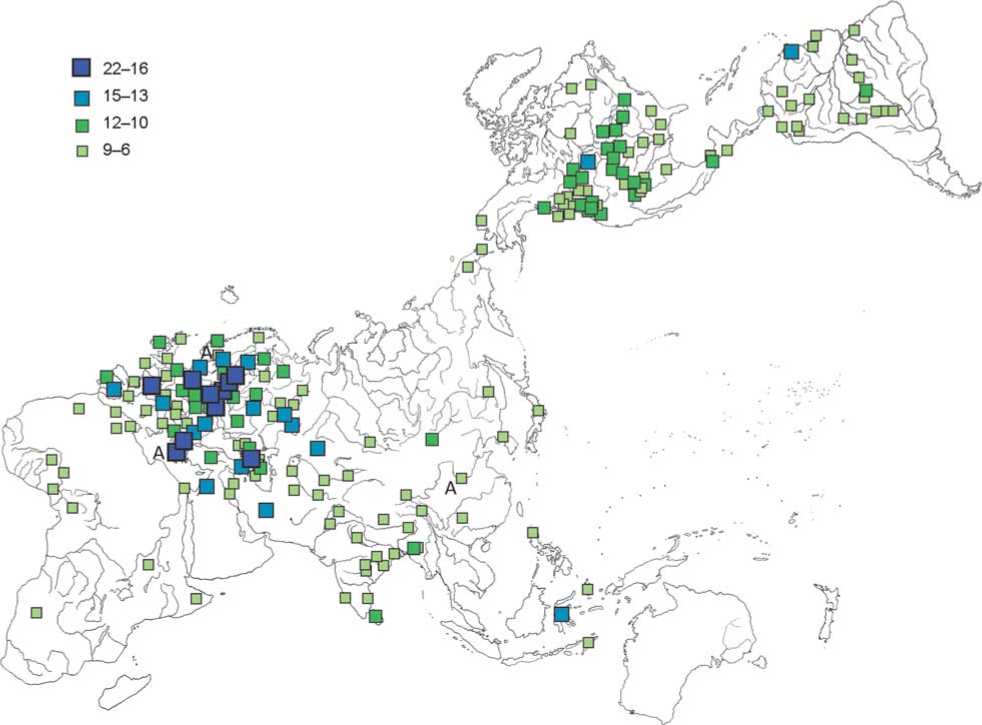
Fig. 3 . Distribution of the selected motifs typical of Western Eurasia and America, but unknown in most of Siberia. Size and color of the signs correspond to the number of motifs (from 22 to 6) found in each tradition.
the Lower Amur basin (Nanai people), Far Northeast (Chukchi and Asian Eskimos), and Altai (Altai-Kizhi), the number of these motifs does not exceed 3 or 4, and more often is between 0 and 2. More Western Eurasian parallels have been discovered in Asia to the south of Siberia. At the same time, only the Khalkha Mongols, Sinhalese people, Chin people, and Torajans have more than nine of them.
The exclusive parallels between the traditions of the populations of Western and Central Eurasia, and Plains Indians (Fig. 4) are of particular interest. We did not take these data into account while compiling map 3, since they have some specific features. In the New World, the area of occurrence of the corresponding motifs* is sharply bounded by the Rocky Mountains in the west, and stretches across the entire Plains from north to south. In Eurasia, the maximum number of parallels has been found not only in the mythologies of Europe, but also in the Turkic-Mongolian traditions of the south of Siberia and Turkestan. These parallels were noticed twenty years ago and were regarded as resulting from migration of the ancestors of the Native Americans from the Altai-Sayan to the New World (Berezkin, 2003). After reaching Alaska and moving along the Yukon and Mackenzie valleys, people entered the expanses of the Plains. They must have gradually dispersed further, although in the Mackenzie Corridor migration could have been more rapid. In the intermediate territories of Siberia and American Northwest, the corresponding motifs should have been known at one time, but were erased during migrations.
American regional traditions do not constitute a unity, but find parallels in different regional traditions of Eurasia. This conclusion has later found more and more proofs (Berezkin, 2016a, 2018c, 2019, 2020a). There are almost no doubts that we are dealing here with isolated events in peopling of the New World. The
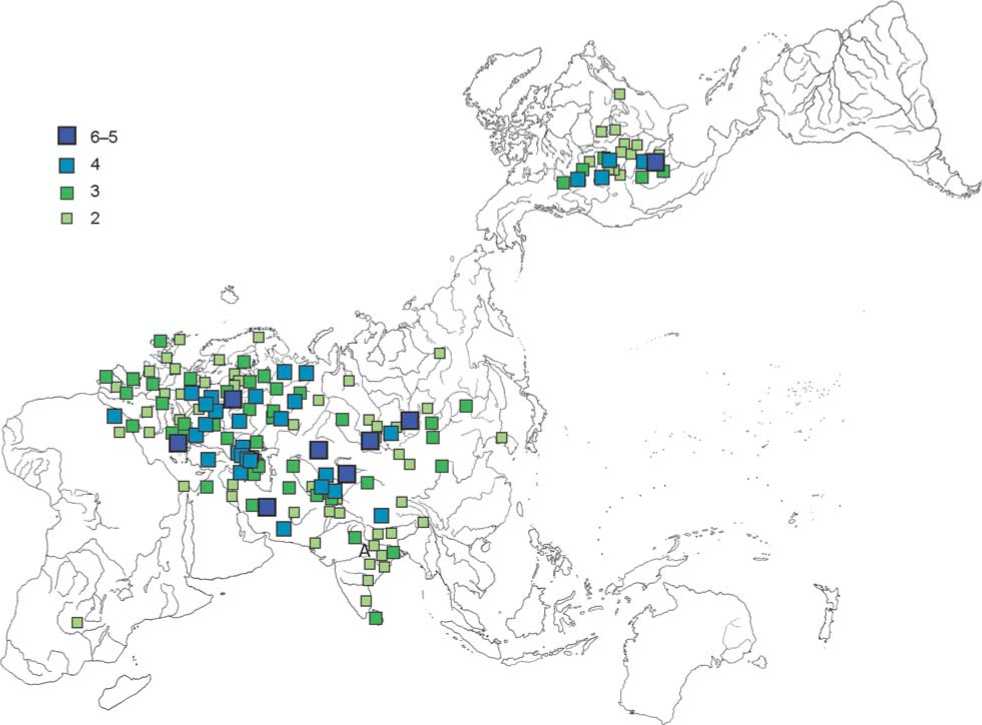
Fig. 4 . Distribution of the selected motifs typical of Western Eurasia and the Great Plains. Size and color of the signs correspond to the number of motifs (from 6 to 2) found in each tradition.
movement of people from Southern Siberia to North America is possible, since genetic data also point to this area of the Old World as the main source of the Y-chromosomal lineages in the New World (Wei et al., 2018). However, this scenario is vulnerable. First, there is no archaeological evidence for early migration along the Mackenzie Corridor. Fluted points found in Alaska were brought there not from Asia, but relatively late from the mainland of the future United States (Vasiliev et al., 2015: 171–177). Second, as our catalogue becomes enriched with many thousands of European, West Asian, and North African texts, it is clear that in the realm of folklore and mythology, American connections are not specific to Southern Siberia, but are typical of the entire area west of the Altai.
Noteworthy is a small group of motifs connecting the north of North America and Chukchi Peninsula with Northern Europe, especially with the Sami people and the Baltic Finns*. The concentration of parallels in the
Bering Strait region suggests the later penetration of motifs from Asia into America than those concentrated in the Plains. However, in this case too, the contacts between the Chukchi Peninsula and Fennoscandia could hardly have taken place given the ethno-linguistic situation in Siberia known to us, since in the past it should have been significantly different (Fig. 5).
While working on Project 21-18-00232 supported by the Russian Science Foundation, we tried to identify any parallels connecting the ancient mythologies of Western Asia with both Ancient Greek and late folklore traditions of Eurasia and America. This work is not finished yet. However, even if the number of identified motifs increases (now it is in the range of 35–55 for each of the ancient traditions), it is unlikely that many parallels will be found.
creation: creaking of trees), b75b1 (Sounds in the time of creation: voice of the wife or mother-in-law), b91a (Eyes: taken and not returned), k25a2 (Downcast feathers), L101 (Downcast clothes), L41с (Those sliding down the hill were taken away by a demon), M42b (Eyes of tar), m97 (The blind man asks the trees).
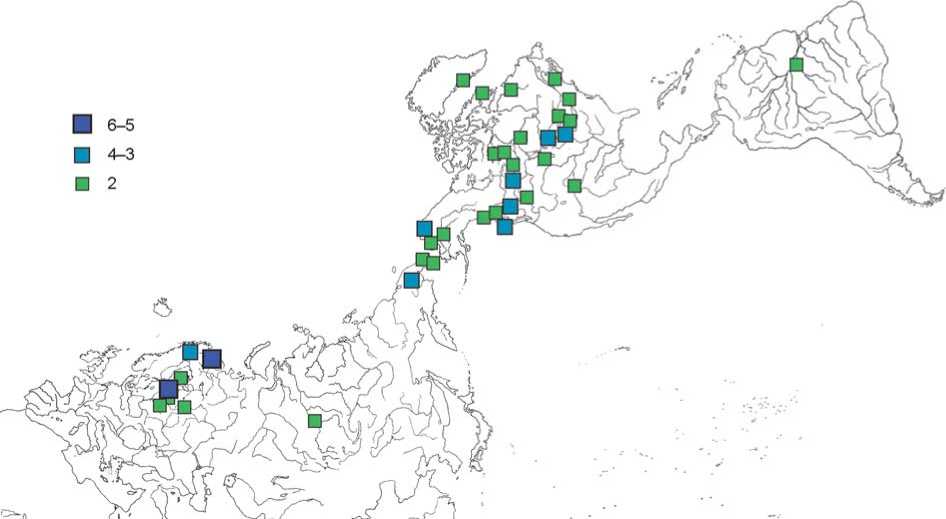
Fig. 5 . Distribution of the selected motifs typical of Northern Europe, the Bering Sea, and north of North America. Size and color of the signs correspond to the number of motifs (from 6 to 2) found in each tradition.
As far as the parallels between Europe and America are concerned, we are apparently dealing with the northern zone with which the traditions of Western Asia had nothing to do. This is a separate topic, which deserves special research.
Population history of Eastern Siberia
The data of folklore and mythology do not have their own dating. If antiquity of plots and genres is assessed only from the content of the texts, it is very dependent on the intuition of the researcher and cannot have objective confirmation. We may get on a relatively firm ground only when we discover the areas of large groups of motifs. These data can be correlated with the boundaries of the distribution zones of human communities, which archaeologists and geneticists identify for specific chronological periods. The coincidence of the boundaries in the areas suggests the possibility that certain sets of motives emerged within the communities (spheres of interaction) that existed only in certain periods. Notably, this concerns epochal periodization, and not calendar dates.
Samples of fossil DNA that were analyzed in recent years have made it possible to establish the population history of Eastern Siberia in general terms (Kozintsev, 2021: 142; Sikora, Pitulko, Willerslev, 2019). Before the peak of the glacial maximum, in the north of the region (Yana site), there lived people genetically close to
European populations, particularly to the inhabitants of the Sungir site (Massilani et al., 2020). There is similar data for the Malta site in the Baikal region; some genes of its inhabitants later came to America (Balter, 2013). The relationship between the population of the Malta site (Baikal region) and the Upper Paleolithic population of Europe is also indicated by odontological evidence (Shpakova, 2001). The gene pool of the ancient Northern Siberians living on the lower Yana River also had East Asian component, although it was not predominant. By the beginning of the Holocene, the situation had changed significantly. As the deciphered genomes have shown, the man from the lower Kolyma River (Duvanny Yar site) partially retained the gene pool of the ancient Northern Siberians, and was close to the Eskimos and Native Americans (Sikora, Pitulko, Willerslev, 2019). The population with links to American people also remained in the Cis-Baikal region in the Final Paleolithic (Yu et al., 2020). However, 6000–4000 years ago, the genetic ancestors of the people who were encountered by the Russian pioneers already lived both in the north of Eastern Siberia and in the Cis-Baikal region.
Time-related changes in the gene pool of Eastern Siberia suggest a gradual shift of the region’s population to the north. As the Ice Age passed away, biocenoses typical of a very cold climate were replaced by more thermophilic biocenoses. Natural zones moved to the north, and populations adapted to them moved up along (Pavlova, Pitulko, 2020; Pitulko, Pavlova, 2020). However, there is no exact evidence that archaeological complexes discovered in the north of Eastern Siberia originate from the southern part of the region. It can be argued that archaeological evidence does not contradict the data of genetics, but it also does not contain additional justification for the reconstructed process, only testifying to the increased demographic density.
It is still difficult to establish where the population that spread to the north of Eastern Siberia originally emerged; possibly, in Manchuria, in the east of Mongolia, and in Transbaikal region. There are no arguments in favor of migration from the areas south of Manchuria. The populations with the pebble tool industry lived in South China; throughout the entire Upper Paleolithic, they were pushed from the north by the people of blade industry (Bar-Yosef, Belfer-Cohen, 2013: 37–38). The earliest genome of an anatomically modern human in China (the sample was extracted from a femur found in the Tianyuan cave in Zhoukoudian, near Beijing) dates back to ca 40 ka BP (all dates are calibrated), and is located almost at the base of the lines leading to various populations of East Asia and America (Gakuhari et al., 2020: Fig. 4; Kaifu, Fuhita, 2011; Shang et al., 2007; Wang, Yeh, Reich, 2021).
The origin of the population of Eastern Siberia is an issue not directly related to the topic of this article and is beyond the competence of the author. If paleogenetic data are obtained for the population of Transbaikalia and Amur region, the situation will most likely become clearer. It is important that in the period between about 20 and 5 ka BP, there was a radical change in the composition of the population in that region, at least in its northern part, and in the Cis-Baikal region. People who lived there in the Pleistocene shared more genes with both inhabitants of Western Eurasia and Native Americans, than the Yukagirs, Yakuts, Tunguses, or Buryats do.
The data of genetics, archaeology, linguistics, and comparative mythology rarely coincides in detail, since different features of culture, just as genes, are transmitted in different ways (see (Berezkin, 2018b)). The coincidence is more noticeable at the highest, transcontinental level, when specific tendencies balance each other. Changes in the gene pool of the Eastern Siberia population in the Late Pleistocene and Early Holocene well correlate with data of comparative mythology. These changes make it possible to explain how it could happen that significant sets of elements of oral tradition, common to Western Eurasia and the New World, are almost absent from Siberia. Our working scenario is as follows.
Anatomically modern humans peopled continental Eurasia 45–40 ka BP (Bae, Douka, Petraglia, 2017; Fewlass et al., 2020; Pitulko, Pavlova, 2020); that is, around the same time when the populations from Africa reached the Indo-Pacific Rim of Asia (Massilani et al., 2020; O’Connell, Allen, 2015). This dating is consistent with disappearance of the “Hobbits” from the Island of
Flores ca 50 ka BP (Sutikna et al., 2016). The penetration of Homo sapiens into Australia and New Guinea earlier than 50 ka BP cannot yet be ruled out (Bradshaw et al., 2021), but it is not supported by indisputable evidence. There is no information on penetration of Homo sapiens in the territory of China north of the Yellow River earlier than 40 ka BP, and in the areas located to the south earlier than 50–45 ka BP (Sun et al., 2021).
The set of mythological motifs brought from Africa must have been small (Berezkin, 2021). After peopling of Eurasia by the Homo sapiens , contacts between the northern (continental Eurasian) and southern (IndoPacific) populations could not have been intense, since Central Asian deserts and mountains separating them were rarely inhabited, especially during the glacial maximum (Morgan et al., 2011). As a result, different sets of folklore and mythological motifs emerged in the north and southeast of Eurasia.
People began to enter the New World after the peak of the glacial maximum had been over. The most ancient reliably dated sites in America date back to 16.5–15 ka BP (Prates, Politis, Perez, 2020; Williams et al., 2018). The earliest groups might have been not continental Eurasian but Indo-Pacific (Australasian) populations. This is indicated both by our data on the distribution of mythological motifs (Fig. 6)*, and by exclusive correspondences in the gene pool of some Amazonian Native Americans, Papua people, and Andamanese people (Skoglund et al., 2015). At the same time, such conclusion cannot be drawn based on craniological traits of modern populations (Turbon, Arenas, Cuadras, 2017). There is also no Australasian trace in the DNA
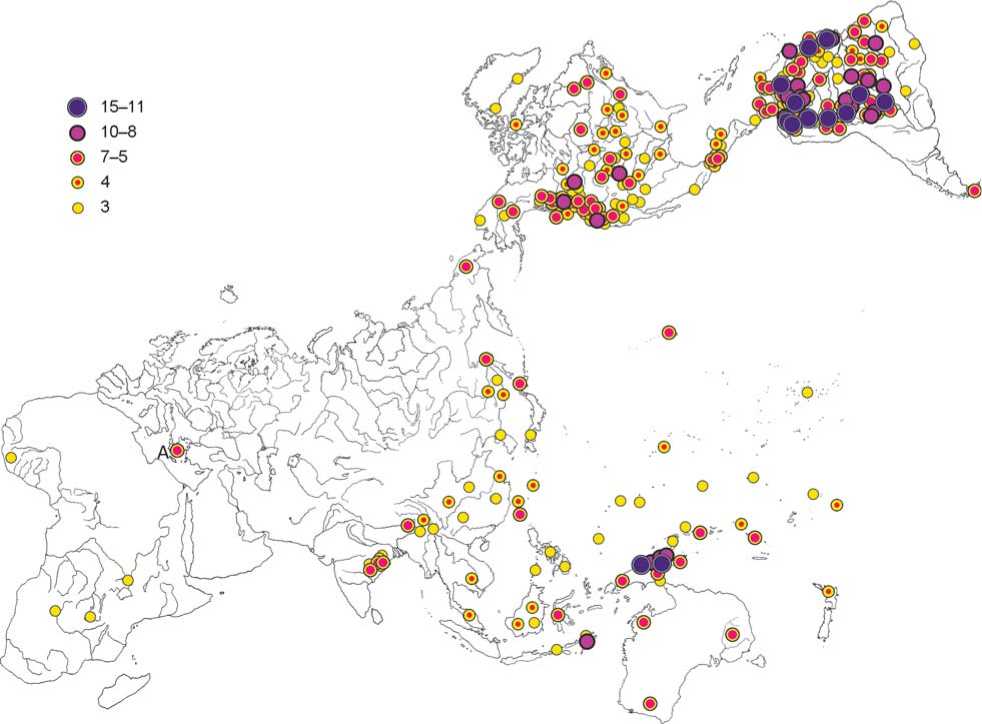
Fig. 6 . Distribution of the selected motifs typical of America and Indo-Pacific Rim of Asia. Size and color of the signs correspond to the number of motifs (from 15 to 3) found in each tradition.
samples taken from human fossils in North America, including Anzick and Spirit Cave, associated with two major Paleo-Indian cultural complexes—the Clovis and Western Stemmed Points Tradition. This trace is noticeable, albeit weakly, only in South America, while all the studied samples there belong to the Holocene (Moreno-Mayar et al., 2018).
Importantly, the topics of the circum-Pacific motifs used in creating the map in Fig. 6 and motifs linking Eurasia and America (see Figs. 2–5) are systematically different. The former include the episodes of ancient African origin, explaining the origin of death (a36, h4, h11) (Berezkin, 2021). The rest are mainly associated with etiology, especially human anatomy and gender relations. Over a half of the Western Eurasian-American parallels are the episodes of adventure and trickster-related narratives. Since adventure motifs of African origin could not be identified at all, these are apparently later than the mythological motifs sensu stricto (related to cosmology and etiology).
Not later than the Final Pleistocene, the descendants of the early inhabitants of Eastern Siberia (non-Mongoloid groups and those not associated with the Indo-Pacific world) entered the New World. The systematic parallels between Western Eurasia and America can be best explained by the presence of a once-existing boreal cultural continuum from the Atlantic to the Bering Sea region, which was continued in America. The change in the population of Eastern Siberia during the Holocene led to disruption in this continuum.
However, the question remains: why is the set of mythological motifs of the 1st millennium BC, known from Ancient Greek sources, is statistically closer to the traditions of the Native Americans than the late European folklore?
In the earlier published articles, we tried to show the role of Siberian and Central Asian narrative traditions in formation of European folklore known from the records of the 19th century (Berezkin, 2016b, 2018b, 2020b). Late folklore of Europe emerged not only on the basis of borrowings from Western Asia (largely from those available in written form) and the local substratum, which is difficult to reconstruct (for an attempt at such reconstruction, see (Berezkin, in press)). No less important, if not a decisive, role was probably played by the transfer of motifs from east to west during migrations across the Great Steppe from the Hunno-Sarmatian period and up to the 17th century (the Kalmyks). Taking into account the anthropological similarity between the Royal Scythians and the Tuvan Okunev population (Kozintsev, 2007), it can be assumed that this process had begun even several centuries earlier. The motifs brought from Siberia and Central Asia had a particularly strong influence on the traditions of Eastern Europe (Berezkin, 2016b), but this influence affected the entire Western Eurasia. And if the Mongol conquests of the 13th century are well described in the written sources, the processes that took place in the mid 1st millennium AD are known only in general terms, and it is almost impossible to evaluate the dynamics of changes in the sets of motifs in Western Eurasia after Antiquity, since there are no data. One thing is clear: there is a huge gap between the Hellenistic-Roman period and the 17th– 18th centuries, when European folklore started to be reflected in publications.
Conclusions
None of the conclusions drawn from behind the desk work may on their own serve as a basis for large-scale reconstructions. This is the privilege of sciences based either on experiment or on direct observation. Remaining within the boundaries of comparative folklore, we would have never taken the liberty of proposing a historical scenario explaining the similarity of motifs in Western Eurasia and America. This became possible only thanks to successes of genetic and archaeological research whose results are in good agreement with analysis of tens of thousands of folklore and mythological texts. It may be the case that this interpretation is incorrect and another one will be proposed instead. Yet the facts on which it rests seem reliable; they have been accumulated over several decades and were not collected for any specific hypothesis.
The list of Western Eurasian-American parallels is open and is updated with accumulation of new data. The motifs widespread in the Old and New Worlds, but unknown in Africa (except for North Africa), such as Clashing rocks (i22) or Eyelids of Viy (h54) are of particular interest. There is little doubt that such motifs appeared after leaving Africa, but it is still difficult to establish exactly where and in which ways they spread. It would be interesting to find it out also because the chains of motifs identified in the texts make it possible to detect ancient cultural connections between human communities. Such connections and exchange of ideas largely determined the course of history, and the more ancient period they belonged to, the greater their consequences might have been.
Acknowledgments
This study was a part of the Project 21-18-00232 of the Russian Science Foundation. The author thanks E.N. Duvakin, A.G. Kozintsev, and O.V. Yanshina for their corrections, ideas, and information.
Список литературы The cultural continuum of the Eurasian boreal zone and the Eastern Siberian wedge (based on comparative mythology and paleogenetics)
- Adams R.N. 1975 Energy and Structure. A Theory of Social Power. Austin and London: Univ. of Texas Press.
- Bäcker J. 1988 Märchen aus der Mandschurei. München: Diederichs.
- Bae C.J., Douka K., Petraglia M.D. 2017 On the origin of modern humans: Asian perspectives. Science, vol. 358 (6368). https://doi.org/10.1126/science.aai9067.
- Balter M. 2013 Ancient DNA links Native Americans with Europe. Science, No. 342: 408-409.
- Bar-Yosef O., Belfer-Cohen A. 2013 Following Pleistocene road signs of human dispersals across Eurasia. Quaternary International, vol. 285: 30-43.
- Berezkin Y.E. 2003 Southern Siberian - North American links in mythology. Archaeology, Ethnology and Anthropology of Eurasia, No. 2: 94-105.
- Berezkin Y. 2007 Dwarfs and cranes. Baltic Finnish mythologies in Eurasian and American perspective (70 years after Yriö Toivonen). Folklore (Tartu), No. 36: 75-96.
- Berezkin Y.E. 2016a Rezultaty obrabotki dannykh o raspredelenii folklornomifologicheskikh motivov v Severnoy Azii (yuzhnoaziatskiye i amerikanskiye svyazi). Yazyki i folklor korennykh narodov Sibiri, No. 2 (31): 5-14.
- Berezkin Y.E. 2016b Vostochnoslavyanskiy folklor v yevropeiskom i yevraziyskom kontekste (rezultaty statisticheskoy obrabotki dannykh). Antropologicheskiy Forum, No. 31: 9-24.
- Berezkin Y.E. 2018a Manifestation of worldviews in traditional narratives: Reconstruction of global tendencies in the spread and the chronology of emergence of mythological motifs. Archaeology, Ethnology and Anthropology of Eurasia, vol. 46 (2): 149-157.
- Berezkin Y.E. 2018b Samodiyskaya kosmologiya v sibirsko-severoamerikanskom kontekste. Uralo-altayskiye issledovaniya, No. 2 (29): 18-29.
- Berezkin Y.E. 2018c Sibir i Tsentralnaya Aziya kak innovatsionniy region (materialy folklora). Antropologicheskiy Forum, No. 39: 33-51.
- Berezkin Y. 2019 Athabaskan-Siberian folklore links: In search of Na-Dene origins. Folklore (London), vol. 130 (1): 31-47.
- Berezkin E.Y. 2020a Sibirskiy folklor i yego sosedi. Vestnik Tomskogo gosudarstvennogo univeriteta. Istoriya, No. 68: 89-97.
- Berezkin Y.E. 2020b Vostochnoslavyanskiy folklor v yevraziyskom kontekste. Slavyanovedeniye, No. 6: 41-55.
- Berezkin Y.E. 2021 Afrikanskoye naslediye v mifologii. Antropologicheskiy Forum, No. 48: 91-114.
- Berezkin Y.E. (In press) Nekotoriye ranniye motivy v folklore Yevropy. (In press).
- Berezkin Y.E., Duvakin E.N. (s.a.) Tematicheskaya klassifi katsiya i raspredeleniye folklornomifologicheskikh motivov po arealam. Elektronniy analiticheskiy katalog. Last update January 2022. URL: http://www.ruthenia.ru/folklore/berezkin
- Boas F. 2002 Indian Myths and Legends from the North Pacifi c Coast of America. Vancouver: Talonbooks.
- Bradshaw C., Norman K., Ulm S., Williams A.N., Clarkson C., Chadoeuf J., Lin S.C., Jacobs Z., Roberts R.G., Bird M.I., Weyrich L.S., Haberle S.G., O’Connor S., Llamas B., Cohen T.J., Friedrich T., Veth P., Leavesley M., Saltré F. 2021 Stochastic models support rapid peopling of Late Pleistocene Sahul. Nature Communications, vol. 12 (2440). https://doi.org/10.1038/S41467-021-21551-3.
- Fewlass H., Talamo S., Wacker L., Hublin J.-J. 2020 A 14C chronology for the Upper Palaeolithic transition at Bacho Kiro Cave, Bulgaria. Nature Ecology & Evolution, vol. 4: 794-801.
- Gakuhari T., Nakagome S., Rasmussen S., Allentoft M., Sato T., Korneliussen T., Chuinneagáin B.N. 2020 Ancient Jomon genome sequence analysis sheds light on migration patterns of early East Asian populations. Communications Biology, vol. 3 (437). https://doi.org/10.1038/s42003-020-01162-2.
- Haas A. 1903 Rügensche Sagen und Märchen. Stettin: Johs. Burmeister’s Buchhandlung.
- Kaifu Y., Fuhita M. 2011 Fossil record of early modern humans in East Asia. Quaternary International, vol. 248: 2-11.
- Karlin A.S. 1991 Frantsuzskiye narodniye skazki. Moscow: Sov. pisatel: Olimp.
- Kozintsev A.G. 2007 Scythians of the North Pontic Region: Between-group cranial variation, affi nities, and origins. Archaeology, Ethnology and Anthropology of Eurasia, No. 4: 143-158.
- Kozintsev A.G. 2021 Patterns in the population history of Northern Eurasia from the Mesolithic to the Early Bronze Age, based on craniometry and genetics. Archaeology, Ethnology and Anthropology of Eurasia, vol. 49 (4): 140-151.
- Kuhn T. 2003 Struktura nauchnykh revolyutsiy. Moscow: Yermak. Massilani D., Skov L., Hajdinjak M., Gunchinsuren B., Paabo S. 2020 Denisovan ancestry and population history of early East Asians. Science, vol. 370 (6516): 579-583.
- Millroth B. 1965 Lyuba. Traditional Religion of the Sukuma. Uppsala: Univ. of Uppsala.
- Moreno-Mayar V.J., Vinner L., Barros Damgaad P., de, Fuente C., de la, Willersleb E. 2018 Early human dispersals within the Americas. Science, vol. 362 (6419). https://doi.org/10.1126/science.aav2621.
- Morgan C., Barton L., Bettinger R., Chen F., Dongju Z. 2011 Glacial cycles and Paleolithic adaptive variability on China’s Western Loess Plateau. Antiquity, vol. 85 (328): 365-379.
- O’Connell J.F., Allen J. 2015 The process, biotic impact, and global implications of the human colonization of Sahul about 47,000 years ago. Journal of Archaeological Science, vol. 56: 73-84.
- Pavlova E.Y., Pitulko V.V. 2020 Late Pleistocene and Early Holocene climate changes and human habitation in the arctic Western Beringia based on revision of palaeobotanical data. Quaternary International, vol. 549: 5-25.
- Pitulko V.V., Pavlova E.Y. 2020 Colonization of the Eurasian Arctic. In Encyclopedia of the World’s Biomes, vol. 2. Amsterdam: Elsevier, pp. 374-391.
- Prates L., Politis G.F., Perez S.I. 2020 Rapid radiation of humans in South America after the last glacial maximum: A radiocarbon-based study. PlosOne. 22 July. https://doi.org/10.1371/journal.pone.0236023.
- Shang H., Tong H., Zhang S., Chen F., Trinkaus F. 2007 An early modern human from Tianyuan Cave, Zhoukoudian, China. Proceedings of the National Academy of Sciences USA, vol. 104 (16): 6573-6578.
- Shimkevich P.P. 1897 Obychai, poverya i predaniya goldov. Etnografi cheskoye obozreniye, vol. 34 (3): 135-147.
- Shpakova E.G. 2001 Paleolithic human dental remains from Siberia. Archaeology, Ethnology and Anthropology of Eurasia, No. 4: 64-76.
- Shtal I.V. 1982 Epicheskiye predaniya Drevney Gretsii. Geranomakhiya. Moscow: Nauka.
- Sikora M., Pitulko V., Willerslev E. 2019 The population history of northeastern Siberian since the Pleistocene. Nature, vol. 570: 182-188.
- Skoglund P., Mallick S., Bortolini M., Chennagiri N., Hünemeier T., Petzl-Erler M.L., Salzano F.M., Patterson N., Reich D. 2015 Genetic evidence for two founding populations of the Americas. Nature, vol. 525: 104-108. https://doi.org/10.1038/nature14895.
- Sun X., Wen S., Lu C., Zhou B., Curnoe D., Lu H., Li H., Wang W., Cheng H., Yi S., Jia X., Du P., Xu X., Lu Y., Lu Y., Zheng H., Zhang H., Sun C., Wei L., Han F., Huang J., Edwards R.L., Jin L., Li H. 2021 Ancient DNA and multimethod dating confirm the late arrival of anatomically modern humans in southern China. Proceedings of the National Academy of Sciences, vol. 118 (8). https://doi.org/10.1073/pnas.2019158118.
- Sutikna T., Tocheri M., Morwood M., Saptomo E.W., Jatmiko, Awe R.D., Wasisto S., Westaway K.E., Aubert M., Li B., Zhao J., Storey M., Alloway B.W., Morley M.W., Meijer H., Bergh G., van den, Grün R., Dosseto A., Brumm A., Jungers W.L., Roberts R.G. 2016 Revised stratigraphy and chronology for Homo fl oresiensis at Liang Bua in Indonesia. Nature, vol. 532: 366-369. https://doi.org/10.1038/nature17179.
- Toivonen Y.H. 1937 Pygmäen und Zugvögel. Alte kosmologische Vorstellungen. Finnisch-Ugrische Forschungen, Bd. 24 (1/3): 87-126.
- Turbon D., Arenas C., Cuadras C.M. 2017 Fueguian crania and the circum-Pacific rim variation. American Journal of Physical Anthropology, vol. 163 (2): 295-316.
- Vasiliev S.A., Berezkin Y.E., Kozintsev A.G., Peiros I.I., Slobodin S.B., Tabarev A.V. 2015 Zaseleniye chelovekom Novogo Sveta: Opyt kompleksnogo issledovaniya. St. Petersburg: Nestor-Istoriya.
- Wang C., Yeh H., Reich D. 2021 Genomic insights into the formation of human populations in East Asia. Nature, vol. 591: 413-419. https://doi.org/10.1038/s41586-021-03336-2.
- Wei L.-H., Wang L.-X., Wen S.Q., Yan S., Canada R., Gurianov V., Huang Y., Mallick S., Biondo A., O’Leary A., Wang C., Lu Y., Zhang C., Jin L., Xu S., Li H. 2018 Paternal origin of Paleo-Indians in Siberia: Insights from Y-chromosome sequences. European Journal of Human Genetics, vol. 26: 1687-1696. https://doi.org/10.1038/s41431-018-0211-6.
- Williams T.J., Collins M.B., Rodrigues K., Rink W.J., Prewitt E.R. 2018 Evidence of an early projectile point technology in North America at the Gault Site, Texas, USA. Science Advances, vol. 4 (7): 1-7. https://doi.org/10.1126/sciadv.aar5954.
- Yu H., Spyrou M.A., Karapetian M., Krause J. 2020 Paleolithic to Bronze Age Siberians reveal connections with fi rst Americans and across Eurasia. Cell, vol. 181: 1-14.

